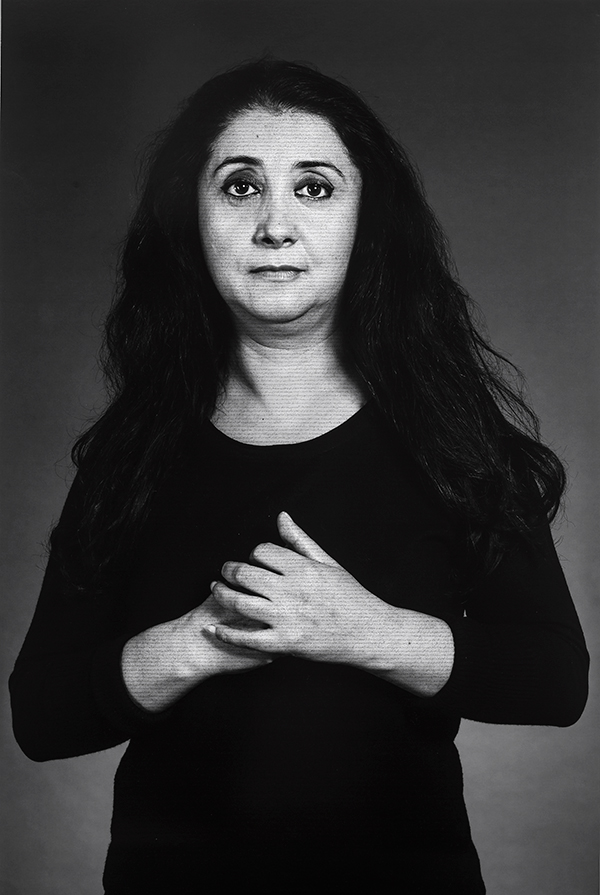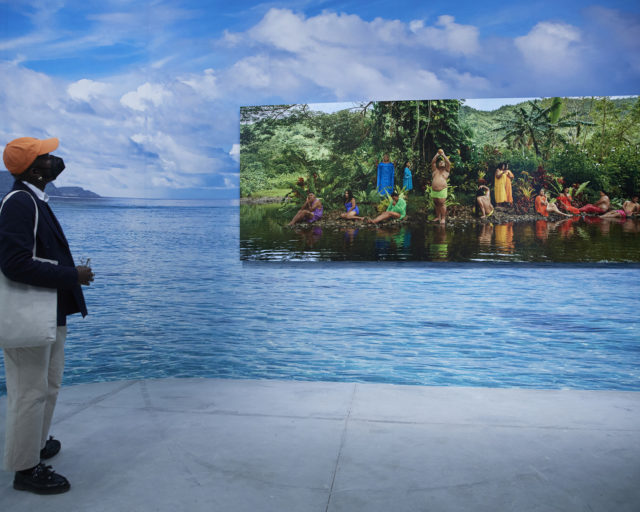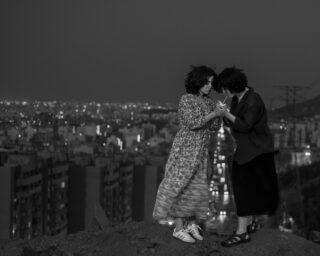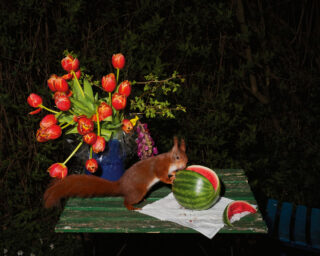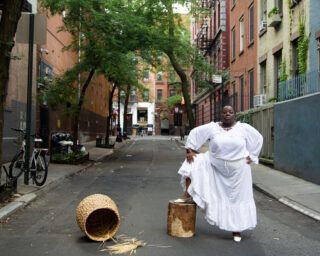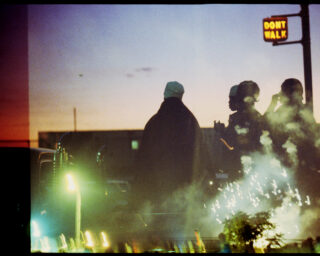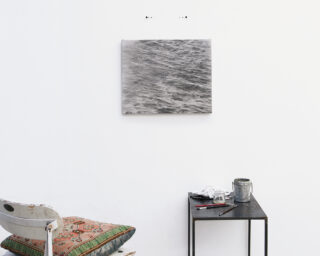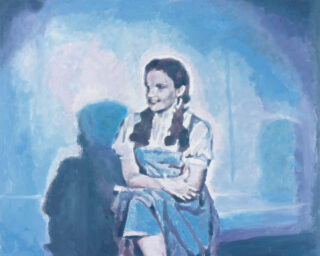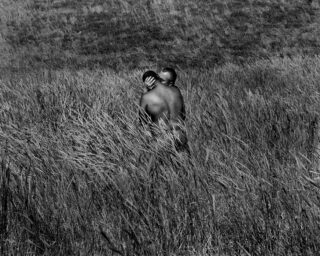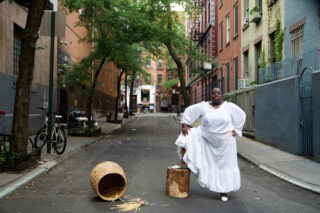Shirin Neshat, Ilgara, 2015, from the series, The Home of My Eyes
Courtesy Written Art Foundation, Frankfurt am Main, Germany
“Taking photographs is an action,” János Vető noted in 1973, referring to his collaboration with Hungarian performance artist Tibor Hajas, currently on view at the 57th Venice Biennale. In their 1970s photographic series, Surface Torture, each piece shows a gridded progression of images, invoking the narrative of a film. In a particularly unnerving sequence, a dark figure against a black background pulls white goo—a mask? paint?—off his face. The gritty, high contrast images give the illusion that Hajas is peeling away his own skin. Taking a picture is an integral part of the performance, not just a tool for documentation: each action was performed for the camera. The two mediums work well together, and neither is upstaged. The wall text, however, tells another story: Hajas’s name appears at the top, where the artists’ names are usually listed, and Vető is relegated to a secondary status, appearing, in significantly smaller type, three lines below.
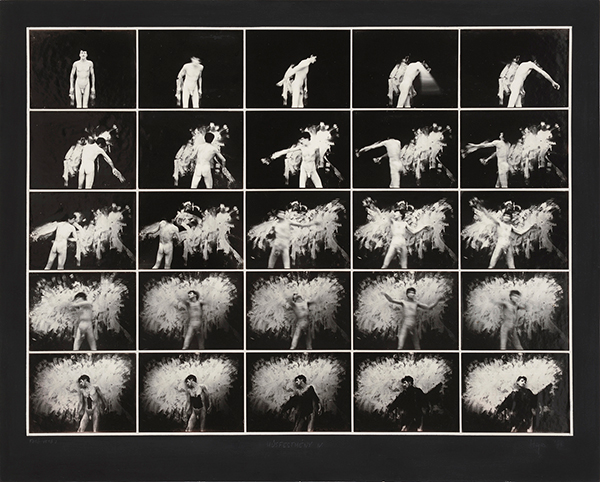
© Estate of Tibor Hajas and János Vető
Courtesy Ludwig Museum, Budapest
Almost every time photography appears in the Venice Biennale, especially in the marquee exhibition, VIVA ARTE VIVA, it’s either in service of something else—performance, collage, film, books—or it’s one element of a larger, multimedia project. Out of eighty-seven national pavilions, only three exhibitions are dedicated solely to a photographer: Australia, Belgium, and Poland. Perhaps this dearth of photography is a reflection of a contemporary art market that favors painting and sculpture. But the argument for photography as art was made, and won, a long time ago. At the Biennale, with its multistory sculptures and flashy installations, photographs alone can’t compete with the spectacle. Which isn’t to say that photography doesn’t work well in conjunction with other modes of art making, such as with Hajas’s performances. But, too often, it gets lost in the fray. Genre-bending multimedia work—where most new art seems to be headed—can be timely and powerful, and at the Biennale, there is painting and sculpture aplenty. Why is photography still denied the same consideration?

Courtesy Branka Stipancic
VIVA ARTE VIVA, a two-part extravaganza curated by Christine Macel, begins at the Giardini and continues into the Arsenale. Immediately upon entering the Giardini, visitors are faced with ten prints by Croatian artist Mladen Stilinović. In the first eight, Artist at Work (1978), Stilinović lies in bed in different positions. The last two, taken three decades later, Artist at Work Again (2011) show Stilinović slumbering on a bench in a white cube exhibition space. Stilinović appears to ask, how does a Western culture that values productivity over health and leisure affect art making? While these pictures offer a witty critique, Stilinović is a Conceptual artist, not a photographer. Conceptual art pushed for the dematerialization of the art object, to make the idea more valuable than the object. Appropriately, the prints don’t offer much in the way of formal accomplishment or visual pleasure. In 1978, this approach to photography would have been exciting. Now, it’s a one-liner, an amuse bouche for the more important work that follows.
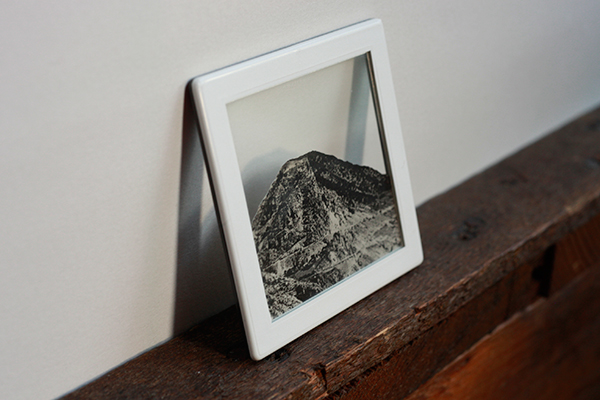
Courtesy of the Artist
Hajra Waheed’s piece A Short Film, 1–321 (2014) combines photography with archival material. Here, and in two adjacent works, the artist has collaged postcards into hundreds of blank slides, placed in neat rows on a wooden shelving unit. (A Short Film, 1–321 also includes two framed works comprised of cut photographs on cork, which are not on view.) Waheed grew up in Dhahran, a gated, residential compound for Saudi ARAMCO employees. According to the artist, the company strictly regulated civilian use of cameras and video equipment, but surveillance was pervasive. Waheed’s work often concerns geopolitics, and migration in particular, but the links to these topics can be difficult to trace. This lyrical and poignant work is part of a larger, multimedia project, Sea Change (2011–ongoing), sourced from the same set of photographic postcards from the 1930s and ’40s, and set in the Western Himalayas. A black-and-white landscape, often a lonely hill or mountain, juts into each frame; the rest is clear glass, representing the gaps in the story. The incorporation of photography works well here because the project itself is about who has the right to make images.

Courtesy La Biennale di Venezia
Elsewhere in the Biennale’s main exhibition, however, photography is often lost among the many materials in various multimedia projects. Thu-Van Tran, a French Vietnamese artist, presented an installation concerned with the global, geopolitical history of rubber trees. This topic could be a fascinating point of departure but, instead, veers into a clichés of contemporary art: large-scale installations, vaguely global projects, and a toothless critique of the West. Tran’s project is too broad in both idea and execution. Rubber casts of rubber trees lie atop coffin-like crates, and a dual projection video flickers nearby. Superficially, the installation looks polished, professional. Plus, it helpfully takes up a large amount of space in the capacious Arsenale. Candy-colored drip painted walls form the background for gigantic photograms, which resemble Anna Atkins prints from the mid-nineteenth century—but without her dexterity, grace, or eye for composition. There are too many mediums at play, and Tran has unfortunately dragged photography into the mix.
WithinVIVA ARTE VIVA, Eileen Quinlan’s pictures of nudes were one of the few examples of freestanding photographs meant to be seen on their own. The seven prints, which are not a formal series, show her post-pregnancy body, as well as that of another young mother. Yet the wall text apologizes for this inclusion by explaining that Quinlan and her artistic peers, “felt the urgency to free the photographic medium of its technical hyper potential,” which sounds nonsensical. The didactic reads as if a camera were a shackle, from which the artist is desperately trying to liberate herself. Pushing the boundaries of the medium, and making images that are messy and unique, are both older strategies than the crisp, consumable images of the past one hundred years: think of wet-plate daguerreotypes, or Man Ray’s Surrealist photograms. Still, Quinlan’s subject works well with the dripping, black-and-white presentation. Achieving this effect by using vintage Polaroid film, she explained in an interview with Marie Sarre, “As the bodies depicted are undergoing the ravages of time, of child-birth, and even surgery, the film itself is also being transformed by its age.”

Courtesy the artist and Miguel Abreu Gallery, New York and Campoli Presti, London/Paris
An official collateral exhibition at the Museo Correr, Shirin Neshat: The Home of My Eyes, presents photographs from a 2015 series of the same name, and a video, Roja (2016). Situated on St. Mark’s Square, this civil museum occupies a building known as the Napoleonic Wing, resplendent with Neoclassical treasures. Following room after room of opulent nineteenth-century furniture and gilded religious paintings, Neshat’s grid of black-and-white photographs is striking—minimal, contemporary, powerful. A large sculpture of the Virgin Mary, ostensibly part of the museum’s collection, hangs in the middle of the wall. This gesture of religious cohabitation relates to the subjects’ poses, in particular, their hand positions, which were inspired by El Greco.
Throughout her career Neshat has focused on Iran, but this expansive series of photographs show people from neighboring Azerbaijan. During the sittings, Neshat interviewed her subjects, who varied in age and ethnicity, about cultural identity and the concept of home. Each portrait is inscribed with ink, and draws from these conversations, as well as from poems by Nizami Ganjavi, a twelfth-century poet born in present-day Azerbaijan. The script is difficult to discern, as most of the pictures are hung far above eye-level, and there is no translated text on the wall, or in a booklet. For visitors lacking extraordinary vision and a grasp of Farsi, these stories will unfortunately remain unknown. Though more context would have been illuminating, Neshat’s exhibition proves that, even in Venice, photography can be relevant and contemporary—if given the chance.
The 57th Venice Biennale, including VIVA ARTE VIVA, is on view through November 27, 2017. Shirin Neshat: The Home of My Eyes is on view at the Museo Correr, Venice, through November 26, 2017.










